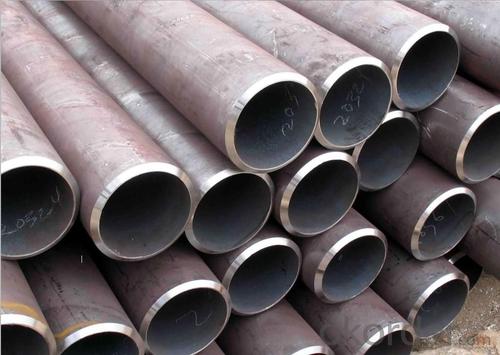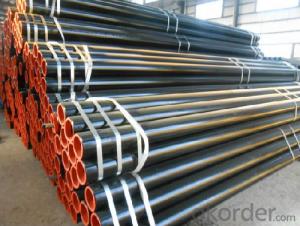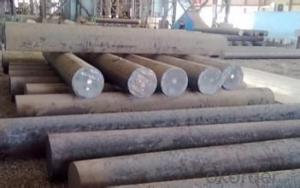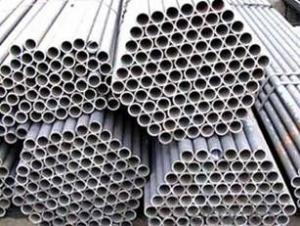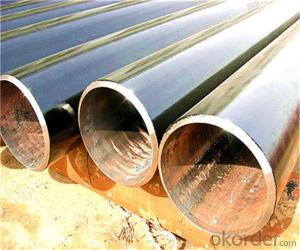seamless steel tubes for construction
- Loading Port:
- Shanghai
- Payment Terms:
- TT OR LC
- Min Order Qty:
- 2000 m.t.
- Supply Capability:
- 10000 m.t./month
OKorder Service Pledge
OKorder Financial Service
You Might Also Like
Product Description:
Standards:
GB,_r81 62 Chinese national standard
ASTM A53 Standard of American Society of Testing Materials
ASME SA53 Boiler and pressure vessel--c-Ojrde of ASME
Application:
Seamless steel tubes for manufacturing pipelines。vessels,equipment and mechanical structures
Models of major steeI tubes:
1 O,20,35、45,Q345,1 5CrMo,1 2Crl MoV,A53A,A53B,SA53A,SA53B, etc.
Diamensional tolerances:
Types of steel tubes | Outer diameter | Wall thickness | ||
Cold-rolled tubes | Tube sizes(mm) | Tolerances(mm) | Tube sizes (mm) | Tolerances(mm) |
>30~50 | ±0.3 | ≤30 | ±10% | |
>50~219 | ±0.8% | |||
Hot-rolled tubes | >219 | ±1.0% | >20 | ±10% |
Mechanical properties:
Standard codes | Models of steel tubes | Tensite strength(MPa) | Yield strength(MPa) | Elongation(%) |
GB/T8162 | 10 | ≥335 | ≥205 | ≥24 |
20 | ≥390 | ≥245 | ≥20 | |
35 | ≥510 | ≥305 | ≥17 | |
45 | ≥590 | ≥335 | ≥14 | |
Q345 | ≥490 | ≥325 | ≥21 | |
15CrMo | ≥440 | ≥295 | ≥22 | |
12Cr1MoV | ≥490 | ≥245 | ≥22 | |
ASTM A53 ASME SA53 | A | ≥330 | ≥205 | Check the table in ASTM A 53 |
B | ≥415 | ≥240 |
Chemical composition:
Standard codes | Models of steel tubes | Chemical compositions(%) | |||||||||
C | Si | Mn | P | S | Cu | Ni | Mo | Cr | V | ||
GB/T8162 | 10 | 0.07~0.14 | 0.17~0.37 | 0.35~0.65 | ≤0.035 | ≤0.035 | ≤0.25 | ≤0.25 | / | ≤0.15 | / |
20 | 0.17~0.24 | 0.17~0.37 | 0.35~0.65 | ≤0.035 | ≤0.035 | ≤0.25 | ≤0.25 | / | ≤0.25 | / | |
35 | 0.32~0.40 | 0.17~0.37 | 0.50~0.80 | ≤0.035 | ≤0.035 | ≤0.25 | ≤0.25 | / | ≤0.25 | / | |
45 | 0.42~0.50 | 0.17~0.37 | 0.50~0.80 | ≤0.035 | ≤0.035 | ≤0.25 | ≤0.25 | / | ≤0.25 | / | |
Q345 | 0.12~0.20 | 0.20~0.55 | 1.20~1.60 | ≤0.035 | ≤0.035 | ≤0.25 | ≤0.25 | / | ≤0.25 | / | |
15CrMo | 0.12~0.18 | 0.17~0.37 | 0.40~0.70 | ≤0.035 | ≤0.035 | ≤0.25 | ≤0.30 | 0.40~0.55 | 0.80~1.10 | / | |
12Cr1MoV | 0.08~0.15 | 0.17~0.37 | 0.40~0.70 | ≤0.035 | ≤0.035 | ≤0.25 | ≤0.30 | 0.25~0.35 | 0.90~1.20 | 0.15~0.30 | |
ASTMA53 ASMESA53 | A | ≤0.25 | / | ≤0.95 | ≤0.05 | ≤0.06 | ≤0.40 | ≤0.40 | ≤0.15 | ≤0.40 | ≤0.08 |
B | ≤0.30 | / | ≤1.20 | ≤0.05 | ≤0.06 | ≤0.40 | ≤0.40 | ≤0.15 | ≤0.40 | ≤0.08 | |
- Q: What is the typical length of a steel pipe?
- The typical length of a steel pipe can vary depending on its purpose and application. However, standard lengths for steel pipes often range from 20 feet to 40 feet.
- Q: How much is the wall thickness standard of building 48?
- According to the "construction of fastener type steel pipe scaffold safety technical specifications JGJ130-2011" stipulates that the specification of steel pipe should be Phi 48.3 * 3.6, that is, wall thickness is 3.6mm.
- Q: Can steel pipes be used for conveying compressed air?
- Yes, steel pipes can be used for conveying compressed air. Steel pipes are known for their high strength and durability, making them suitable for handling high-pressure applications such as compressed air systems. Additionally, steel pipes are resistant to corrosion and can withstand extreme temperatures, making them a reliable choice for conveying compressed air.
- Q: How do you calculate the flow rate in a steel pipe?
- When calculating the flow rate in a steel pipe, several factors must be taken into consideration. The primary factor to consider is the cross-sectional area of the pipe, which can be determined using the formula A = πr², where A represents the cross-sectional area and r represents the radius of the pipe. Afterwards, it is necessary to ascertain the velocity of the fluid moving through the pipe. This can be accomplished by utilizing the equation v = Q/A, where v denotes the velocity, Q represents the volumetric flow rate, and A represents the cross-sectional area of the pipe. To determine the volumetric flow rate, one can employ the equation Q = AV, where Q represents the volumetric flow rate, A represents the cross-sectional area, and V represents the average velocity of the fluid. Furthermore, it is essential to take into account the properties of the fluid being transported through the pipe. Factors such as density and viscosity can impact the flow rate. In conclusion, the flow rate in a steel pipe can be calculated by determining the cross-sectional area of the pipe, calculating the velocity of the fluid, and considering the properties of the fluid being transported.
- Q: What is the difference between seamless steel pipe and welded pipe?
- The main molding process is different. Ordinary steel pipes, such as tap water pipes, are usually welded by bending flat plates, and you can find a seam on it;
- Q: How are steel pipes inspected for defects?
- Steel pipes are typically inspected for defects using various non-destructive testing methods such as ultrasonic testing, magnetic particle inspection, and visual inspection. These techniques help identify any cracks, corrosion, or other defects in the pipes, ensuring their structural integrity and quality.
- Q: Heating system DN40 and DN32 welded steel pipe how to connect?
- Is the wire: also called pipe thread connection, the malleable steel pipe fittings, malleable iron is the thread connection using DN40X32 diameter hoop.
- Q: What is the composition of steel pipes?
- Steel pipes are primarily composed of iron and carbon, with small amounts of other elements such as manganese, silicon, and sulfur.
- Q: Can steel pipes be used for industrial ventilation systems?
- Yes, steel pipes can be used for industrial ventilation systems. Steel pipes are commonly used in industrial settings due to their durability, resistance to extreme temperatures, and ability to handle high-pressure applications. They provide a reliable and long-lasting solution for transporting air in ventilation systems, ensuring proper airflow and maintaining a safe and healthy environment in industrial facilities.
- Q: What are the different types of steel pipe supports for offshore platforms?
- There are several different types of steel pipe supports used for offshore platforms, including pipe racks, pipe clamps, pipe hangers, and pipe saddles. Pipe racks are used to support multiple pipes and provide a structure for them to rest on. Pipe clamps are used to secure individual pipes to structures or walls. Pipe hangers are used to suspend pipes from overhead structures, while pipe saddles are used to support pipes on horizontal surfaces. These different types of supports are designed to ensure the stability and integrity of the pipes in offshore environments.
Send your message to us
seamless steel tubes for construction
- Loading Port:
- Shanghai
- Payment Terms:
- TT OR LC
- Min Order Qty:
- 2000 m.t.
- Supply Capability:
- 10000 m.t./month
OKorder Service Pledge
OKorder Financial Service
Similar products
Hot products
Hot Searches
Related keywords



